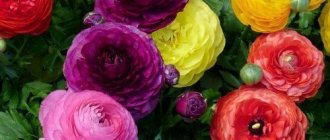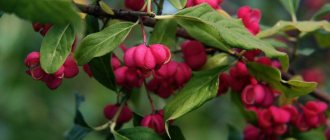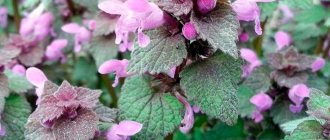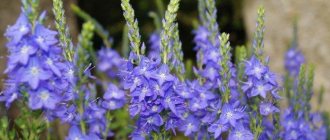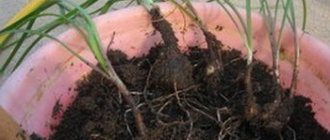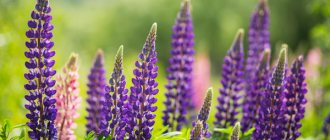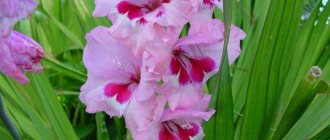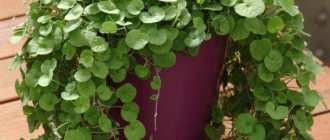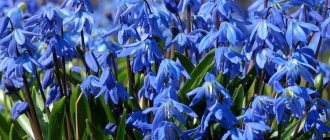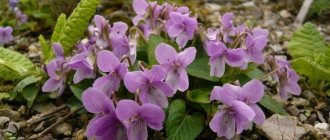Perhaps everyone has seen this plant - spreading stems, decorated with carved leaves and bright flowers of an unusual shape, as if divided into two halves. This dicentra is a perennial popular with gardeners around the world. Moreover, dicentra in Russia can be found not only in parks and front gardens: many species also grow in the wild. But the plant is mainly widespread in North America and Asia.
The luxurious dicentra (lat. Dicentra) began its journey from the mountainous regions of eastern Asia to Europe in the middle of the 18th century. And the first person to describe and classify dicentra was the famous Swedish explorer C. Linnaeus. The unpretentious perennial was classified as a member of the poppy family (lat. Papaveraceae).
The appearance of the dicentra is impressive: gracefully curved, racemose peduncles are covered with white, pink, purple or yellow flowers, reminiscent of a heart, in the middle of which are hidden white droplet petals. Due to the special structure of the flowers, the graceful plant appears in many European romantic legends. There is a belief that these flowers bring good luck in love and marriage. For example, in Germany they believe that a girl who sees a dicentra and picks a branch of it will definitely soon meet her groom.
In each country, the flower was called differently: “broken heart” in Russia, “Jeannette’s heart” in France, “Our Lady’s slipper” in Poland, “lady’s medallion” in England. The official scientific name of this plant is not so lyrical: literally translated from Latin, the word “dicentra” means “two-spurred.” The fact is that the shape of the inner petals of the dicentra, on which nectar accumulates, really does look a little like cavalry spurs.
The perennial is given additional decorativeness by its bluish-green, lace-like leaves and herbaceous spreading shoots.
general information
Now it’s difficult to say exactly where such a bizarre flower came to us from. But Japan is traditionally considered the birthplace of the Broken Heart. Since then, dozens and even hundreds of annual and perennial varieties have appeared, but the heart-shaped buds remain unchanged.
The Broken Heart flower has a very strong and developed root system, which allows it to adapt to different conditions. The stems can be straight or branched, up to 100 cm high. The leaves differ in shape, size and shade. The flowers are most often pink or white.
Another nice feature of the plant is that it can bloom twice a year. To do this, it is enough to immediately remove faded buds and flower stalks so that they do not drain resources.
Photo: artmaki.su
Propagation of dicentra by cuttings
Cuttings are another method of propagation. Held in early spring. Cuttings 15 cm long are cut. Young shoots are selected for this. Old or damaged branches will not work. Then the cuttings are dipped into a container with a root formation stimulator. Good growth accelerators:
- "Kornerost".
- "Zircon".
- "Kornevin".
- "Heteroauxin".
Advice. It is a good idea to add vitamin C or vitamin B1 to the root growth accelerator solution. Then the plant will sprout roots and shoots faster.
The cuttings are left in the solution for 24 hours. Then they are planted in flower pots. Cover the top with a jar and remove it after a couple of weeks. But rooted cuttings can be transplanted into the garden no sooner than after a year.
Types of Flower Broken Heart
Speaking about the varieties of this unusual and bizarre flower, I would like to first highlight several main categories. It is on their basis that modern varieties and hybrids are bred.
Spectabilis
Or, as we call it, the magnificent dicentra. This is the tallest species with powerful large bushes and dissected leaves. The height easily reaches 1 m. Even after flowering, the plant retains its decorative appearance.
Photo: ogorodmechty.com
Eximia
This variety is sometimes called Bleeding Heart. And all because the flowers intertwine all shades of pink and purple. Dicentra is exceptionally or excellently resistant to heat and is not afraid of temperature changes.
Photo: raiclimat.ru
Peregrina
She is a wandering dicentra and a real relic, because her ancestors were known more than a thousand years ago. This is a very tiny plant, but with large white, pink or purple flowers.
Photo: botanichka.ru
Formosa
Or the dicentra is beautiful. This is a compact and very elegant species with a height of only 40 cm. There are very delicate and beautiful shades of cream, milky, pastel pink and even red.
Photo: floribunda.ru
Scandance
The original liana-like form of the so-called climbing dicentra. Creeping shoots grow up to 2 m. There are varieties with rare shades, like golden, but this is still the same Broken Heart in shape.
Photo: zabor22.ru
Canna flower (60 photos): types, proper care and planting
Description of culture
Dicentra is native to Japan and also grows in eastern China, North America and the Far East. Some species are found wild in the Himalayas. It is grown as a perennial plant, but there are also annuals. Belongs to the Poppy family.
Structural features of the dicentra:
- This is a small shrub reaching a height of 1 m.
- The branches are sinewy, thickened.
- The leaves are pinnately dissected, dark green in color, with bluish edges.
- The flowers resemble the shape of a heart, are located on the branches in an arc, drooping.
- There are spurs on the corolla.
- The color of the inflorescence varies - white, pink, cream, lavender, depending on the variety and type.
- The fruit is a capsule with black seeds.
In garden plots, the plant grows for up to 5 years without replanting. Some species reach a height of 1.5 m with flowers up to 3 cm in diameter. The plant is used in landscape design to decorate flower beds, borders, alpine slides, entrances to terraces, and gazebos.
They look impressive in flower beds as a central element, complemented by low-growing flowers.
In China and Japan, dicentra capulata is used for medicinal purposes, since the juice of this plant species in certain doses can cure some ailments. Only a few species of dicentra are grown - up to 20, in the middle zone there is only one - Broken Heart or Magnificent.
Caring for a Broken Heart Flower
This may sound unexpected, but a broken heart does not require special attention and care. The flower feels great in our latitudes and it is enough to choose a good site for it with good soil.
Temperature and lighting
There are no fundamentally important recommendations on any of these points. The Broken Heart flower blooms spectacularly in the shade and in the sun, and only the duration of this flowering changes. Individual requirements are found only in rare breeding varieties.
Photo: nashgazon.com
Watering
But it’s still worth paying a little more attention to watering. A broken heart does not tolerate drought or too much humidity equally well. In the first case, growth slows down, and in the second, diseases develop. So always focus only on the condition of the soil.
Photo: distano.ru
The soil
To ensure that the plant enjoys lush and long flowering, dig up the soil with humus from autumn before planting. You definitely need a good drainage layer, and for too heavy soil - vermiculite, sand or other loosening agent.
Photo: nagrunte.ru
Fertilizers and fertilizing
Throughout the season, the Broken Heart flower responds very sensitively to feeding. Apply fertilizers every 3-4 weeks in the spring, gradually changing the composition. First, complex fertilizers for the growth of green mass, and then potassium and phosphorus for flowering. In the fall, nitrogen is needed again so that the plant accumulates resources for the next year.
Photo: nagrunte.ru
Wintering
There are many winter-hardy varieties that can easily overwinter directly in the ground without additional problems. But we recommend covering them with peat or spruce branches in case of a snowless winter or sudden spring frosts.
Photo: floralacres.ca
Transfer
As the Broken Heart flower grows and ages, it needs to be replanted. Firstly, the soil will exhaust its capabilities, and secondly, in the process you can divide and rejuvenate the bush. Remember that for all the power of the root system, it is very fragile. Transplantation is done strictly with an earthen lump.
Photo: zabor22.ru
Lilies of the valley (50 photos): types, planting and proper care
How to prepare the soil for planting crops
Despite the fact that dicentra is not capricious, in order to improve flowering, it is necessary to prepare the area for planting and cultivate the soil in the autumn.
The plant feels great in places that are illuminated by the sun, as well as in the shade of a tree, based on which, there should not be any special difficulties with the improvement of the flower. But in places where there is shade, the buds will bloom later.
During the autumn period, you should carefully dig up the area chosen for planting to a depth of about 40 centimeters, and also increase its fertility by introducing humus (about 3 kilograms per square meter). By the way, a multifunctional fertilizer for garden plants in a volume of 15 to 20 grams per 10 liters of liquid will do for mineral nutrition. In the future, when the dicentra begins to produce color, it will need to be fed about 3-4 times, which will guarantee rapid growth and abundant flowering. Following rain or watering, the soil around the plant must be loosened, but very carefully, because the roots of the flower are located side by side to the surface. To weed and loosen the soil, you need to use a tool that resembles a small pitchfork, then the soil cultivation will be gentle, and the fragile roots will not be damaged.
It will be good if the earth is quite light and can easily conduct moisture and oxygen. In the case when the soil is heavy and clayey, it needs to be diluted using river sand or peat, so as not to cause rotting of the roots. Most gardeners create a “pie” during winter, which includes dry straw or reeds, and pave them in layers, and also alternate them with soil in a specially dug hole.
Planting and propagation
The Broken Heart flower is quickly and easily propagated by cuttings from young shoots. Soak them in the stimulator according to the instructions and plant them in containers with loose soil mixture. Moisten the seedlings, cover with film and leave for a month, watering as they dry. Remove the film, and in the spring plant the seedlings in a permanent place.
The second method is dividing the bush. Here it is very important to carefully divide the root so that young buds remain on each division. Let the rhizome dry slightly and plant future bushes in new places.
Photo: lisky.org.ua
Growing dicentra from seeds
Dicentra seeds photo
Growing seedlings begins at the end of February. Even a lazy gardener can master dicentra propagation by seeds:
- Seeds are planted one at a time in cups, watered and covered with film. Shoots appear only after a month. It is important to maintain a constant temperature – 18-20°C.
- You can also sow in a common container, maintaining a distance of 2-3 cm between seedlings.
- After two true leaves appear on the stems, the seedlings will need to be planted into separate containers.
- Caring for growing seedlings is simple: you need moderate regular watering and good lighting.
Dicentra seedlings photo
In late autumn, the seedlings are covered for the winter. For these purposes, a piece of polyethylene is used.
Seedlings grow from seeds for a very long time. The plant will bloom its first buds only in the third year.
Pest and disease control
Most often, only slugs, snails and mole crickets suffer from a broken heart. But routine treatment with insecticides will allow you to forget about this problem.
The appearance of deformed, chaotic spots on leaves and shoots may be a symptom of spotting. Unfortunately, this is an incurable virus, so the diseased plant must be removed by the roots and the soil disinfected with chemicals.
A more common situation is fungus and rot, which develop due to excess moisture in the soil. But even here everything is simple: remove the affected areas, treat the cuts with charcoal and spray the plants with fungicides.
The most dangerous is root rot, because in the later stages the flower cannot be saved. So regularly inspect your plantings for suspicious spots and the structure of shoots and leaves in general.
Photo: pnwhandbooks.org
Celosia (60 photos): types, planting and proper care
How to care for dicentra
The flower is not difficult to care for and does not require a “special approach.” But knowing about its features means getting a beautiful plant in your flowerbed. To do this, you must follow three main rules for caring for a heart flower.
- Watering should be moderate. Flooding of roots can cause rot. The plant may die.
- The soil must be constantly loosened, while removing weeds. Good air exchange is the key to the health and beauty of a flower.
- Spring shelter. On spring days, the threat of frost remains. At this time, tender shoots need heat protection. It is better to cover them at night. The ideal option is non-woven materials.
- Water for irrigation should be soft. It is pre-defended. If the summer is too hot, then you need to water more often than usual. It is important to ensure that excessive moisture does not destroy the roots.
Flower Broken Heart – photo
The Broken Heart flower is a real curiosity in the garden. It simply has no competitors with the same unusual type of inflorescences and buds. Just look!
Photo: gavrishira.blogspot.com
Photo: wallpapersafari.com
Photo: rachelwilliamsonline.com
Photo: victoriadailyphoto.blogspot.com
Photo: dacha73.ru
Photo: plantarium.ru
Photo: asienda.ru
Photo: nn.ru
Photo: pinterest.ru
Photo: polezno-znat.ru
Photo: thespruce.com
Photo: ladyflor.ru Photo: lovely-dom.ru
Photo: sady-msk.ru
Photo: commons.m.wikimedia.org
Photo: flo.discus-club.ru
Photo: commons.m.wikimedia.org
Photo: zen.yandex.ru
Photo: reddit.com
Photo: zen.yandex.ru
Photo: oir.mobi Photo: fotoshkola.net Photo: jhoppers.japanhostel.net
Photo: windowssearch-exp.com
Photo: photo.99px.ru
Photo: avto.goodfon.ru
Did you like the post? Subscribe to our channel in Yandex.Zen, it really helps us in our development!
Dicentra in landscape design
The described culture has found application in various elements of landscape design. It is actively planted in mixed plantings, borders, and rockeries. Tall varieties are used as solitaires or accent plants in group compositions. The wandering variety is used in alpine slides and for decorating slopes. It is recommended to grow it not only in open ground, but also in large clay flowerpots that are placed near the house.
We recommend finding out what a dicentra plant looks like and what its flower structure is.
Features of cultivation in different regions
Planting dicentra is possible in various areas. However, depending on the climatic conditions in each of them, it needs to be grown in a special way. Some activities should be carried out additionally, while others should be abandoned. Many gardeners are concerned about the question of whether it is possible to grow dicentra in the Urals, in the middle zone and in Karelia.
In the Urals
Dicentra is one of the few perennial crops that are suitable for growing in the Urals. If equipped with a good shelter, this plant can perfectly survive the harsh Ural winters. However, in order for the flower to take root well and develop, it cannot be planted in the fall. This must be done exclusively in the spring.
In outskirts of Moscow
Not all types of the described crop are suitable for growing in the middle zone, therefore, before you go to purchase seedlings, you need to familiarize yourself with the list of species that take root well in the Moscow region. In the middle zone, dicentra should be planted in May, when warm weather has already established itself and the threat of returning frosts has passed.
Among them, we can recommend the following types and varieties:
- magnificent;
- beautiful;
- capular;
- golden-flowered;
- single-flowered;
- Golden vine.
Selection and preparation of planting material
When choosing planting material, you should focus on its appearance.
You may also be interested: Secrets of planting and caring for gladioli
When planting by dividing the rhizome, it is necessary to pay attention to its condition (healthy color, integrity, absence of lethargy, absence of rot and dry rot).
When planting by forming sprouts, it is worth cutting only those sprouts that have a whole knee and look healthy (whole trunk, undamaged foliage). Be sure to soak the sprout in sweet water or special liquids to speed up its germination.
If we talk about seeds, then it’s worth trying to artificially germinate a few seeds in a humid environment (constantly watered cotton wool, a small pot of damp soil). If the seed has not sprouted, then you should abandon the idea of sowing these seeds; they will not sprout.
